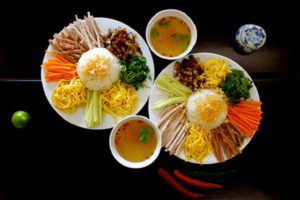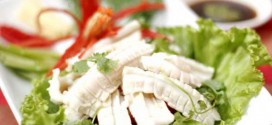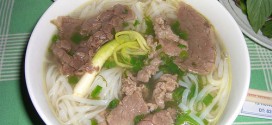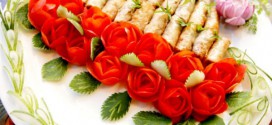Vietnamese cuisine is affected by Yin-Yang and Five Elements theories of Asian philosophy. Instead of focusing on the nutritional value of food, Vietnamese emphasize the combination of ingredients in the dish to create a healthy balance of foods.
Yin-Yang Balance
Yin includes central features such as passivity, cold, dark, and femininity while activity, heat, light, and masculinity are typical of yang.
In food, the distinction between yin and yang does not depend on its physical temperature, but cooling – yin or heating – yang effects on our body after being consumed. Generally, we can determine the yin and yang nature of food through color, taste, and growth situation.
Yin-Yang balance is a mix of yin and yang elements by using the right types of foods at the right time of the year, according to the condition of one’s body to rebalance this connection and enhance our health.
For instance, seafood regarded as yin is regularly suitable to use with hot and spicy spices believed yang such as ginger, chili, and garlic.

Five Elements Balance
According to Five Elements theory, to explain the formation and development of everything in the universe and natural phenomena, people use five symbolic concepts, including Wood, Fire, Earth, Metal, and Water:
Wood: represents spring, the beginning of the transformation cycle, ideas, desires.
Fire: stands for summer, assertiveness, strength.
Earth: the transitional periods between seasons, associated with moderation, result.
Mental: describes as autumn, remodeling, decoration, making things perfect with higher values.
Water: symbolizes winter, when the transformation process is complete, everything transforms into a latent stage, preparing for a new cycle.
Five Elements are known to exist in two typical relationships that create two different cycles:
The generating cycle expresses interactions like engendering or mothering: Wood makes Fire burn, Fire creates Earth, Earth contains Metal, Metal melts into Water, and Water nourishes Wood.
The controlling cycle represents relations like destructing or overcoming: Wood erodes Earth, Earth blocks Water flow, Water extinguishes Fire, Fire melts Metal, and Metal chops Wood.
Vietnamese cuisine has a combination of five basic types corresponding to five elements in each of its features:
Flavors: Sour, Bitter, Sweet, Spicy, and Salty;
Colors: Green, Red, Yellow, White, and Black;
Senses: Sight, Taste, Touch, Smell, and Hearing.
Vietnam dishes attract epicures via five senses: beautifully arranged dishes, full flavor, sounds come from the blend of natural ingredients, and some meals, especially finger food, can be perceived by touching.
 Vietnamese Culture and Tradition
Vietnamese Culture and Tradition 


